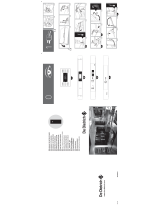
euskara
42
3
Mantenua eta
garbiketa
3.1 Barnealdearen garbiketa. Barnealdea
garbitzeko erabili urez eta bikarbonatoz
bustitako belaki edota zapia. Horrela, usain
txarrak saihestuko dituzu.
Ez erabili inoiz lurrunezko garbiketarako
makinarik ezta disolbagarri edota garbigarri
urratzailerik ere.
3.2 Kanpoaldearen garbiketa. Ez erabili
lurrunezko garbiketarako makinarik pantailak
garbitzeko.
Tenperatura aukeratu ondoren, edukiontzi
bakoitzaren benetako tenperatura ezagutu
dezakezu. Horretarako begiratu argitxoak
(2.3.3) edo sakatu edukiontziaren
edo
botoiak 5 segundo. Edukiontziaren
tenperaturak dir-dir egingo du (2.3.4).
Gomendioak: Hozkailua
gradutan egotea
gomendatzen da, izozkailua aldiz
gradutan (aurretik izoztuta dauden jakiak
gordetzeko). Jakiak izozteko, izozkailuaren
tenperatura
gradutara jaistea
gomendatzen da.
Kontuan hartu barnealdeko tenperatura
hainbat faktoreen araberakoa dela: giro-
tenperatura, kokapena eta hozkailua
irekitzeko maiztasuna.
2.4 Hozkailuaren funtzioak.
Azkar hozteko funtzioa: Funtzio honi esker,
hozkailuaren tenperaturarik hotzena 6 orduz
mantendu daiteke. Hozkailuan elikagai asko
sartzen denean aktibatzea gomendatzen da.
Aktibatu eta desaktibatzeko: Sakatu
(2.4.1, 2.4.2). modeloek ez dute
funtzio hau.
“Oporrak” funtzioa: “Oporrak” funtzioa oso
egokia da hozkailua denbora luzez erabili ez
baina izozkailuko elikagaiak mantendu nahi
badituzu. Funtzio honi esker, zure gailuak
oso gutxi kontsumituko du eta ez da usainik
egongo. modeloek ez dute
funtzio hau.
Oharra: Gailuaren ateak itxita egon behar du.
Aktibatu eta desaktibatzeko: Sakatu
hozkailuaren (2.4.3) edo
,
botoiak display-ean ikurra ikusi arte
(2.4.4). Funtzioa desaktibatzeko errepikatu
aurreko pausuak.
2.5 Hozkailuaren funtzioak.
Azkar hozteko funtzioa: Funtzio honi
esker, izozkailuaren tenperaturarik hotzena
52 orduz mantendu daiteke. Funtzioa
izozkailuan elikagai asko sartu baino 24 ordu
lehenago aktibatzea gomendatzen da.
modeloetan, funtzio hau aktibatu eta 24
ordutara desaktibatu behar da.
Aktibatu eta desaktibatzeko: Sakatu
(2.5.1, 2.5.2, 2.5.3). modeloak ez du
funtzio hau.
“Negua” funtzioa:
modeloetan
soilik. Funtzio hau aktibatu ezazu hozkailuak
hotza galtzen duela ikusten baduzu. Sakatu
5 segundo, argi laranjak dir-dir egin
arte (2.5.4). Gailuaren argia piztuta geratuko
da, potentzia erdian, konpresoreak denbora
gehiago funtziona dezan. Hozkailuak
tenperatura egokia lortzen duenean, “negua”
funtzioa deskonektatu behar da. Horretarako,
sakatu berriro
5 segundo.
Izozkailua konektatu/deskonektatu:
Izozkailuaren edukiontziko
botoia
sakatu (2.5.5). Ondoren, sakatu
edo
displayean tenperatura desagertzen den
arte (2.5.6), edo bira eman aginteari
-era iritsi arte (2.5.7). Izozkailua itzaltzen
denean hozkailua ere itzaliko da.
2.6 Erabilera-gomendioak.
• Ez ireki atea behar baino denbora gehiago
eta ez sartu elikagai berorik gailuan.
Horrela, zure gailua eraginkorragoa izango
da eta energia gehiago kontsumitzea
saihestuko duzu.
• Zure gailua NO FROST bada, ez buxatu
aireztapeneko sareta eta utzi tarte bat
elikagaien artean airea horien artea pasa
dadin.
• Ez sartu edari gasdunik edota likidoa
duten beirazko botilarik izozkailuan lehertu
daitezke eta.
• Sartu elikagaiak edukiontzi hermetikoetan;
horrela ez dira lehortuko.
• Ez jan oso hotz dagoen izozki edota
elikagairik, erredurak eragin ditzakete.















